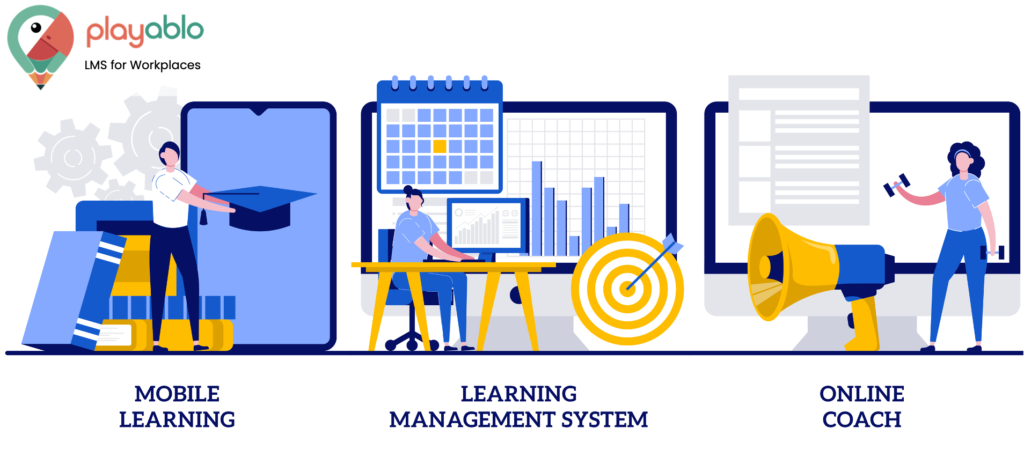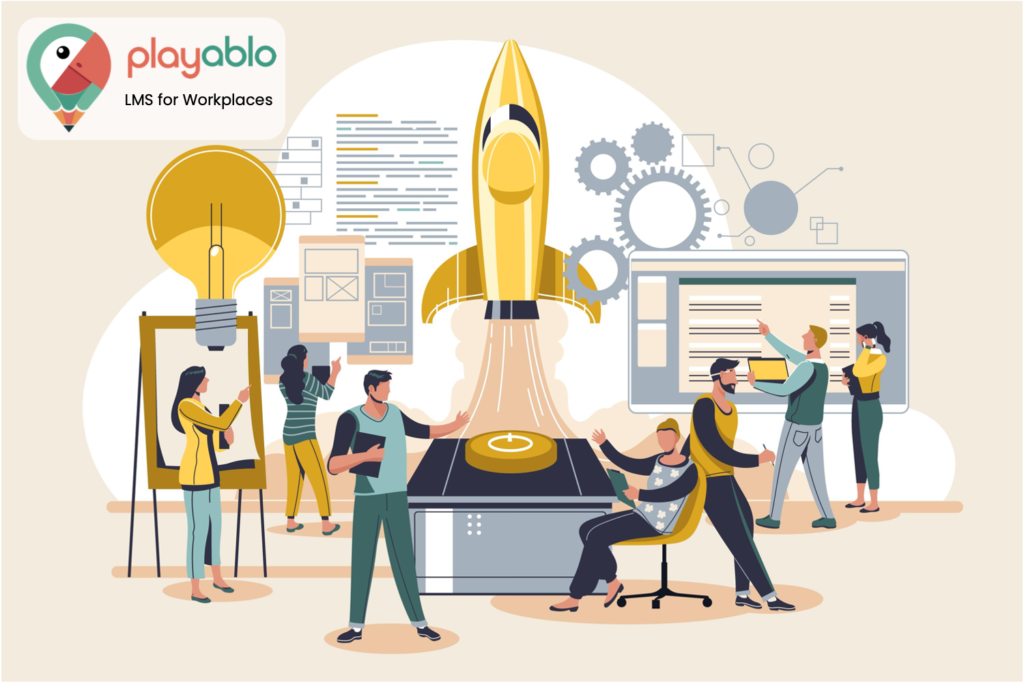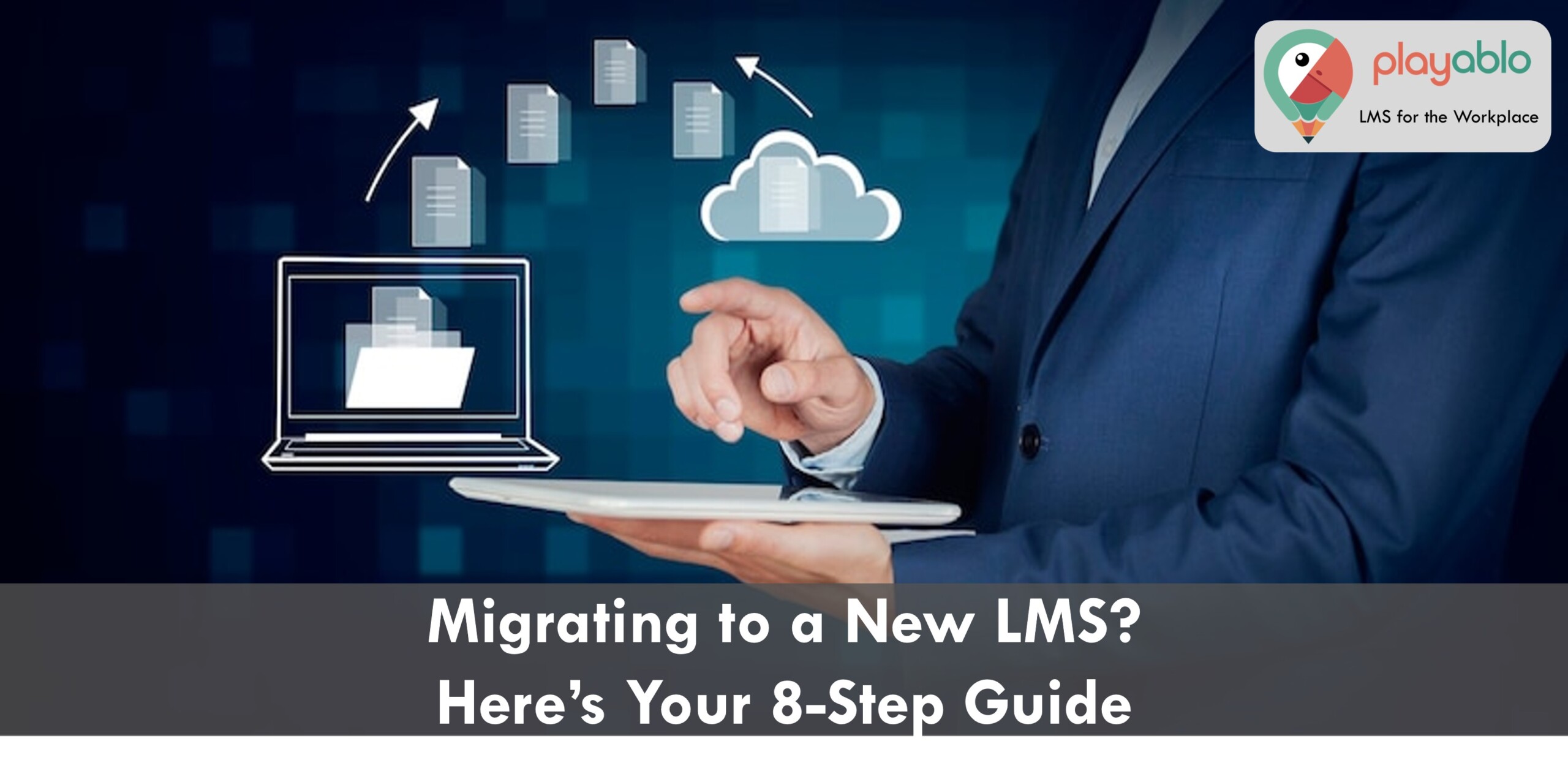Deciding to switch from your existing to a new LMS can be challenging. You need to consider tons of factors, like data migration, course structure, key features, and pricing. Finding the best course structure and comparison between features can take a ton of time and research.
The Product (features/functions/integration), the Vendor (service/support/continuity), and the Cost (annual licensing/maintenance/overhead) are generally the driving forces for an LMS migration. After all, it’s justified. It would help if you accounted for every penny and every expense. LMS migration is a daunting task. But it doesn’t have to be complicated, and you can ease it all with a well-thought strategy. Here is our 8-step LMS migration checklist to get you going.
Table of Contents
Your 8-Step LMS Migration Project Plan

1. Understand Why Your Old LMS Is Unsatisfactory
The first step is to think long and hard about why you are moving LMS platforms. To ensure that all feedback is recorded, speak with various users—learners, content creators, and training managers. Spend time identifying the fundamental problems with the present LMS.
Here are the typical reasons that drive the unsatisfactory performance of LMS in a workplace setting. See if these ring a bell for your environment.
- No All-in-one Learning Platform
To create training, you may use various writing tools, such as a knowledge base, corporate intranet, social media, a quiz-taking service, a webinar-conducting service, and so on. You’ll have to deal with the problem of standardizing the quality of learning content and making training metrics public sooner or later. In this instance, a new LMS may assist in centralizing all training operations and creating a single learning command center.
- Complicated & Costly LMS
Even if you’ve given an introduction lesson, users are still fumbling and bombarding administrators with queries. You may either appoint someone to assist users, produce instructions and video lessons on utilizing your own LMS, or switch to a more user-friendly platform.
Calculate how much you spend on the upkeep of your existing LMS to make a decision. If you move to a new LMS supplier who handles this type of issue, you’ll be able to save money on things like tech support.
- Outdated LMS Solution
If you employ bespoke software, it might rapidly become obsolete. It might cause issues with the support of new eLearning material formats, the inability to use mobile-based eLearning, and the gathering and reporting of non-relevant data. You have two choices: employ a full-time developer to modify your old platform further or migrate to a third-party new LMS. Consider all of the advantages and disadvantages before making your decision.
- Unable to Keep Pace With Business Growth
Let’s assume you want to introduce a new employee incentive program, connect training outcomes with your company’s Business Intelligence system, or dramatically increase the number of learners. Still, your present platform isn’t equipped to do so. In this scenario, please speak with your supplier about their platform development plans. Perhaps for a specific project, you’ll be able to commission a bespoke modification or integration with a third-party service, and that will be enough to address your problem. If any of these needs limit your existing system, it may be time to consider a different platform.
Let us focus on the organizational pain points before drafting the guide for LMS migration.
What Are the Pain Points of Your Current LMS?
Identifying the problem is 60% of the work done. This phase is critical since the rest of the process is dependent on how well the issues are recognized and listed. The reasons for the transition must be established and described in depth. However, it always comes down to the product, the vendor, and the pricing.
Once you’ve determined why you want to switch and defined the success criteria, selecting a new LMS is simple since you know what you want to accomplish.
Your reasons must be valid, and they may include any of the following: ongoing costs, out-of-date technology, after-sales support, low adoption, antiquated interfaces, and so on.
Switching to a new LMS should be a well-thought-out decision since it entails financial and mental resources for businesses. It will be tough to justify the move if you cannot pinpoint the issue areas with your current LMS.
To demonstrate an explicit knowledge of what you’re searching for, we propose holding a problem definition workshop and creating a checklist.

2. List Your Expectations from the New LMS
Once you’ve decided to make the switch, the right place to start is identifying the aspects of your existing LMS that you can’t live without. Also, make a list of less-used features that you might be willing to give up. This step will assist you in making an accurate comparison.
First, list all of the business and training requirements that you wish to address following the move. To do so, form a user group of representatives from several departments and discuss what instructors and workers enjoy and dislike about your existing system. After you’ve written down all of your needs, you may start looking for the best option.
When evaluating a new LMS, please don’t rule out an LMS because it lacks a specific way functionality is implemented. Perhaps the same feature is done differently in that LMS, or there is a suitable workaround. An LMS, for example, may not enable YouTube and Vimeo video embedding but may allow you to submit your videos directly for better IP protection.
A suitable LMS would be easy to use, personalized, efficient, and accessible by all the employees in your organization.
3. Set a Bar on Your Expectations
After you’ve completed the problem-solving exercise, write down your expectations for the new LMS. In this stage, you can modify all of the requirements to align with your company’s objectives. If necessary, you may enlist the help of your various stakeholders to learn about the new features they’re interested in.
Create a comprehensive need definition document and check whether it adds significant value to the present situation. Remember that this paper should be able to address all of the issues raised in the first exercise.
4. Ensure the Feasibility of Your New LMS
Conduct a feasibility study for establishing a new system after identifying the challenges and defining the expectations from the new LMS. This step is where you’ll list some of the major obstacles you’ll experience when implementing the new LMS.
Data migration problems, training history challenges, end-user acceptance willingness challenges, the current team’s ability to cope with the new system, workflow management, and so on are some of the challenges. It would help if you guaranteed that most of these problems are well-considered and handled with the appropriate vendors.
The new LMS provider will generally assist with the content migration stage because they will be familiar with the system and know how to import it correctly. However, make sure you understand what to expect throughout the migration. There are often snags, such as some user properties that they can’t import or course attributes that the new LMS does not support.
5. Kickstart the Migration Process

Identifying the Underlying Challenges
It goes without saying that while moving to a new learning management system, L&D professionals will face a range of obstacles. Change aversion, cost, communication, and bandwidth are among the most frequent roadblocks.
Determine which groups will be affected by the new learning management system and create a list of frequent use cases to outline their system requirements. Write a solid set of LMS challenges based on user data and business procedures. Organise and prioritize the LMS needs into business-critical and essential categories. Please include them in the LMS vendor’s contract.
Setting Up a Power Team
To ensure a smooth transition, an ideal team would include both stakeholders and the IT staff. The stakeholders ensure that the team’s direction and methodology are per the problem description.
Because both teams have different criteria and expectations for the new version, a new standard for identifying the new LMS has been established.
While keeping the project on track and schedule, this team will match stakeholder demands with the organization’s learning and development goal.
- A strong project manager to lead the team
- An executive sponsor to help prioritize the project at the executive level
- An IT partner to ensure that the new LMS meets corporate security requirements and integrates properly with other enterprise systems
- An LMS administrator to act as a liaison between learning tech and learning strategy and manage ongoing projects
- An L&D representative to help the LMS administrator in establishing the LMS per the organisation’s learning objectives.
Jotting Down the Requirements
After the team is in place, the next step is to assess the requirements. Concerning the problem description, needs should be identified based on current usage. The requirement document should include the standard and desirable features (as determined by the problem description) you require from the new LMS.
It’s a good idea to make a priority list with must-have and nice-to-have improvements. Maintain track of the users, any changes in the number of users or the budget, and have those numbers available.
Keeping in Line with Organizational Policies
Corporate and organizational policies change regularly. Determine any critical changes in IT policy, such as data protection and encryption. It is vital to examine the policies and incorporate them in the specifications of the needs to ensure a hassle-free LMS implementation.
Although there is no such thing as the most incredible learning management system on the market, there is a top LMS for your company. Pick the one that fulfills most of your criteria after thorough study.
Taking the Big Step
When everything is set in place and ready to go, take the leap of faith for your organizational growth. Transitioning to a new learning management system takes time, effort, and collaboration from various stakeholders. IT will be critical, and the department must be entirely on board before moving further.
The internal project manager will collaborate closely with the project manager for the LMS partner. They should collaborate to create a project strategy and flow charts to serve as the foundation for each execution stage. Determine the optimum amount of back-and-forth conversation. Some suppliers take an agile approach, sending you roughed-out displays regularly depending on your comments. Other providers take a more systematic approach, providing precise requirements for your approval before development.
6. Stay in the Loop of the Project’s Limitations

It is also critical to grasp the new system’s limits and exclusions throughout the transition process. As previously stated, the data migration activity may integrate legacy data into the new LMS. However, the tangible files/assets that users have contributed in the past (physical files) are frequently not imported (just the outcome of each assignment – score, passed, failed, date).
It’s also necessary to rebuild optimal workflows and other business procedures. These are some of the unknown variables you must address before deciding to move to a new system. Creating a list of use case scenarios and determining the new LMS’s feature readiness
7. Closely Manage Costs
A new learning management system is a significant investment, and cost containment is a top priority for everyone. According to one expert, the easiest way to keep expenses under control is to ensure that everyone is on the same page regarding business procedures and requirements before diving into integration and customization.
The total cost of an LMS ownership includes more than just license and infrastructure expenditures. Hand-holding users, maintaining material, and pulling reports take a lot of time and work. Choose an LMS that improves the efficiency of all of these tasks over your existing LMS.
When you’re looking at different platforms, ask the vendor to let you know if any of the features they’re showing you aren’t included in the standard LMS package and would cost extra to deploy. When you learn that the services you enjoy the most are available as a la carte choices, costs might quickly escalate.
8. Perform Regular Checks
After you’ve completed the LMS transfer, it’s time to look through the new learning platform’s objective process. Ensure that all of the goals and objectives established before the migration are met and that all necessary data is in place. Examine the new LMS’s mobile adaptability, scalability, user signup mechanism, and monitoring of course completion.
For final review and quality assurance, you can conduct a User Acceptance Test (UAT) with end-users and stakeholders. As a result, proper preparation and the appropriate strategy will overcome the common obstacles of an LMS migration and turn it into a smooth activity that can be completed in a short amount of time.
Your One-Stop Solution to the Best LMS option
Moving to a new LMS is based on the initial problem description, which outlines the reason(s) for the transfer. The best practices should essentially be found on the genuine causes, so you may move to a solution that truly fulfills all of the requirements and operates without a hitch.
While traditional business learning systems have controlled how employees learn through top-down formal courses, PlayAblo’s learning platform allows for tailored and automated learning experiences in the flow of work to promote growth, organizational success, and profitability.
PlayAblo also allows your learners to search for specific courses of their interest to create deeper and more successful learning experiences that connect the needs of your business with those of your learners.
PlayAblo boosts your onboarding efforts and encourages formal learning among your employees. You may use dashboards and custom analytics to consolidate and organize courses, distribute and administer online and instructor-led courses, monitor certificates, and measure results. PlayAblo allows you to logically classify your material and make it simpler to locate, as well as automate time-consuming duties for L&D administrators.
If you’d like to learn more about how a new and effective LMS may help businesses overcome the challenges of optimizing their performance, contact the learning specialists at PlayAblo. We’ll show you how our unique approach to LMS fits into your entire business process.
Ad: PlayAblo’s Enterprise-Grade Micro-Learning platform is built for millennial learners. Micro-Learning, assessments, and gamification features ensure learning outcome measurement and sustained engagement.
Find out more and request a custom demo!







Comments are closed, but trackbacks and pingbacks are open.